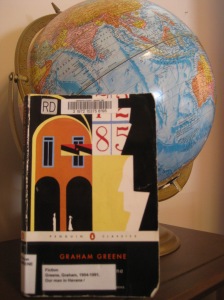Novels That Pass Time’s Test are True Treasures
Posted by Sarah JS
Book Review of Graham Greene’s Our Man in Havana. Published by Penguin.
“Can we write human beings into existence? And what sort of existence? Had Shakespeare listened to the news of Duncan’s death in a tavern or heard the knocking on his own bedroom door after he had finished the writing of Macbeth?” This quote from page 121 of Our Man in Havana, is possibly the root idea that inspired this novel.
Plot Summary
James Wormold, a single father and vacuum-cleaner-salesman in Havana, Cuba, is approached by a stranger who recruits him to become a spy for the Secret Service. Wormold, who is set up as a spineless push-over, believes the stranger is full of crap but lets the situation play out around him. Whatever may be fake, the money the agency sends him is very real. Wormold begins sending the agency fake reports and recruiting fake agents to help him spy on the city. One of his falsified reports sparks action from multiple countries’ agencies, causing his falsified reports to spin into real controversies. One of Wormold’s agents that was only alive on paper, turns up dead in real life. Before he knows it, Wormold is at the center of a deadly political tangle.
Characterization
One of the most wonderful things about writing fiction is that you, as the author, can make everything work in your favor. In order for Wormold to go along with this “spy” business that he clearly thinks is bogus, he needs to be two things: 1) a spineless, go-with-the-flow kind of man and 2) struggling for money. Both are established beautifully by Greene in a scene where Wormold’s daughter asks him to buy her a horse for her birthday. Wormold first rejects, saying his business is struggling and they don’t have the money. After further (but seriously not that much) begging by his daughter, he folds. He agrees to the horse even when he knows he can’t afford it.
A single powerful line of characterization is at the beginning of Part 1, Chapter 4 as Wormold is walking his normal route to a bar in his hometown.
“At every corner there were men who called ‘Taxi’ at him as though he were a stranger…”
A line like this tells us more about Wormold’s character than a hundred stand along adjectives. (Awkward, unconfident, uncomfortable, dorky, foreign, stranger, nervous) Also consider that this line shows the character being acted upon, which explains how others view him. A character’s own actions offer more insight on how they view themselves.
Dialogue
This book has some of the best dialogue I have ever read. Here are some of the highlights that made it stand out:
- It was unpredictable and surprising

- Uncommonly few dialogue tags, yet it was never confusing who was speaking
- It moved the plot along and helped characterize individuals
- Silences were described by the thoughts and actions of the characters instead of “Silence followed” or the like
- It changed subjects randomly
- Those change-of-subjects would often circle around and connect with the original topic
- Characters could hold conversations about two separate topics at one time
This last point was particularly interesting to me. The best example is near the end of the book (pages 157-160) when Wormold is holding a serious conversation with another character while playing checkers. The main conversation is about what is happening in the plot but the characters randomly comment on the game they are playing. Greene’s dialogue is so smooth that he hardly has any dialogue tags and never has to describe what the characters are actually doing. Because they talk about playing checkers, we assume they are sitting at a table, moving their pieces in turn and talking. There is no need for Greene to describe that further. Brilliantly, the conversation of checkers doesn’t only interrupt the main conversation, but also is woven into it. The characters use the game as a metaphor for what is going on in their lives. (I wish I could simply share this section with you but it would be too much of a spoiler. (So please read the book!))
One more specific I will share is how Greene filled a gap in a conversation on page 26. **Spoiler ahead** At this point in the story, the stranger is trying to recruit Wormold to become a spy. He has pulled them into a bathroom and runs a water tap so they won’t be overheard. Wormold is going along with the conversation even when he thinks the stranger is crazy. When they hear another man approaching the bathroom, the stranger forces Wormold into a stall and he pretends to wash his own hands.
“…and then there was silence expect for the running tap. Wormold sat down. There was nothing else to do. When he was seated his legs still showed under the half door. A handle tuned. Feet crossed the tiled floor towards the pissoir. Water went on running. Wormold felt an enormous bewilderment. He wondered why he had not stopped all this nonsense at the beginning. No wonder Mary had left him. He remembered one of their quarrels. ‘Why don’t you do something, act some way, any way at all? You just stand there…’ At least, he thought, this time I’m not standing, I’m sitting. But in any case what could he have said? He hadn’t been given time to get a word in. Minutes passed. What enormous bladders Cubans had, and how clean Hawthorne’s hands must be getting by this time. The water stopped running. Presumably he was drying his hands, but Wormold remembered there were no towels. That was another problem for Hawthorne but he would be up to it. All part of the drill. At last the feet passed towards the door. The door closed.” And the conversation resumes.
In that moment of “silence” Green works in characterization, Wormold’s internal thoughts, setting, the surrounding actions and humor. (The sitting line made me laugh out loud!) Think about this the next time you are writing a moment of silence in your fiction, I know I will!
Transitions
Greene’s transitions help the plot cover a lot of time. Chapter breaks often skip large amounts of unspecified time but Greene does is without causing confusion. The characters often casually allude to how much time has passed and give the reader a little “recap” of what has happened through dialogue. When one character is explaining the events to another character that is just learning of them, it helps the transition feel natural and the information unforced.
A specific interesting transition is when Greene starts a chapter off by explaining a common day-dream of Wormold’s. In the day-dream, he would suddenly realize he was rich but the day-dream was always shattered when he entered the “big American bank” where, in reality, his small savings account was managed. And where should the action start off but inside that very bank. An excellent and clever transition.
Negatives
Although it is more of a style choice than a flaw, there were scenes where Green had very few details in this novel. The heavy reliance on dialogue often took over for the narrator which would be where details were told. I enjoyed the style very much but there were a couple moments when I wished there had been more details. Also, because the novel centered on Wormold, the reader was not present for one of the big scenes in the book when his agent died (though its questionable if it even happened so there is good reason for the reader not to be there).
Recommendation
I recommend this book to everyone! It is an excellent piece of literature as well as entertainment. Five stars! I will specifically recommend this novel to anyone who wants to see how great dialogue is done.
How I found this book: A fellow writer recommended it knowing how much I love great dialogue. Thanks Stephen!
About Sarah JS
Aspiring writer, lover of words, book nerd, working editor, and permanent student of the worldPosted on February 11, 2014, in Book Review and tagged book review, books, characterization, Cuba, dialogue, five stars, graham greene, novel, Our Man in Havana, spy stories, transitions. Bookmark the permalink. 2 Comments.






Pingback: YA Novel Reveals the Human in Us All | Glass Typewriter
Pingback: Review a Classic: The Power and the Glory | Glass Typewriter